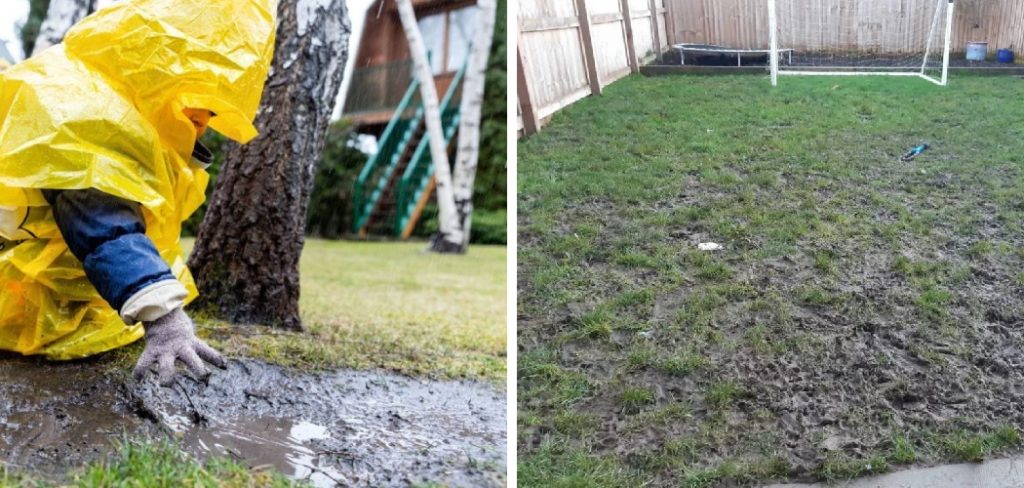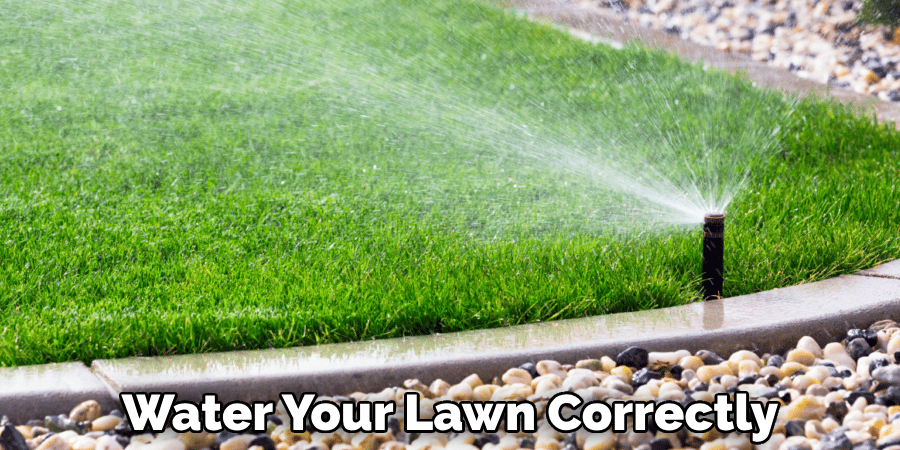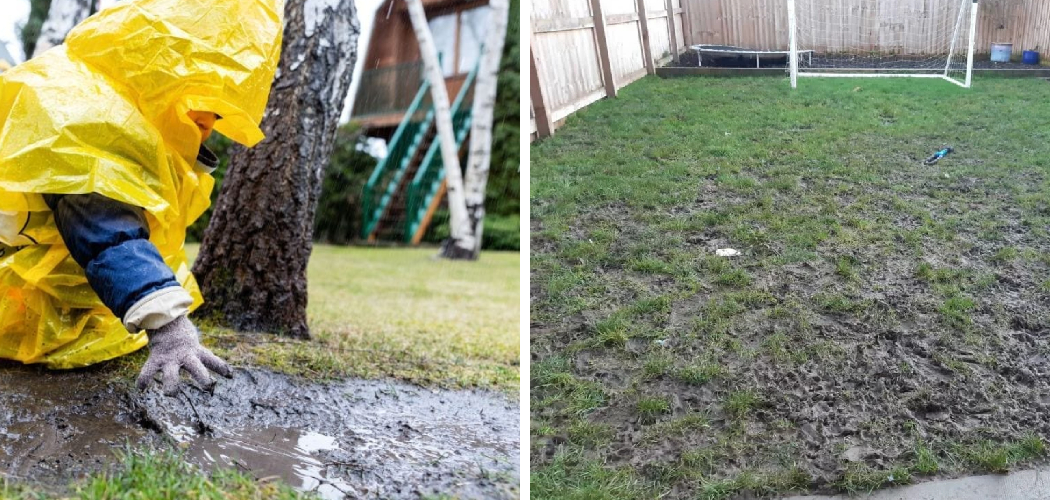How to repair muddy lawn, address the underlying drainage issue and improve soil structure and compaction. A muddy lawn can be a frustrating problem, making it difficult to enjoy your outdoor space.
However, there are solutions to this issue that can enable you to have a lush and healthy lawn. By taking steps to improve drainage and enhance the structure of your soil, you can effectively repair a muddy lawn. This article will provide you with practical tips and techniques to address the problem at its root, allowing you to enjoy a beautiful and mud-free lawn.
From identifying the cause of the issue to implementing the right solutions, you’ll find everything you need to know to restore your lawn to its former glory. So, let’s dive in and learn how to repair a muddy lawn!

How to Repair Muddy Lawn: A Step-by-Step Guide
1. Assessing The Condition Of Your Lawn
Assessing the condition of your lawn is crucial when it comes to repairing a muddy lawn. By determining the extent of the muddy areas, you can start planning the necessary steps. Next, identifying the causes of the muddy areas is essential.
Poor drainage is often to blame, causing water to accumulate and saturate the soil. This leads to the formation of mud patches and a weakened lawn. Understanding the impact of poor drainage on your lawn is important for finding the right solutions.
By addressing the root cause, you can prevent future muddy patches and enjoy a healthier, more vibrant lawn. So, take the time to assess your lawn, determine the extent of the muddy areas, identify the causes, and understand the importance of proper drainage.
Your lawn will thank you!
2. Preparing Your Lawn For Rescue
Preparing your lawn for rescue involves several important steps. First, clear debris and excess organic matter to create a clean surface. Next, aerate the soil to improve drainage and allow water and nutrients to penetrate deeply. This will help prevent future muddy patches.
Additionally, it’s crucial to test the ph level of the soil. A balanced ph ensures optimal grass growth and health. Ensuring that the soil is neither too acidic nor too alkaline is essential for repairing a muddy lawn. By following these steps, you can rescue your lawn and create a lush, vibrant outdoor space.
Keep in mind that regular maintenance is also necessary to prevent the lawn from becoming muddy again.
3. Implementing Rescue Strategies
To repair a muddy lawn, you can implement various rescue strategies. One effective method is to improve drainage by properly grading and leveling your yard. This will ensure that water flows away from the lawn instead of pooling on the surface.
Another option is to install a french drain, which redirects the water flow to a desired location. Additionally, you can consider laying new sod or reseeding the lawn to promote new growth and fill in any bare patches. These steps will help rejuvenate your lawn and provide a healthier, mud-free environment.
Don’t let a muddy lawn bring you down – take action to revive and restore its beauty.
4. Nurturing Your Rescued Lawn
To repair a muddy lawn, there are several techniques you can apply. First, make sure to water your lawn correctly by giving it deep, infrequent watering sessions. This encourages healthy growth and prevents excess moisture. Secondly, applying the right type and amount of fertilizer and nutrients is essential.

This will provide the necessary nourishment for your lawn to thrive. Regular mowing should also be part of your lawn care routine, as it helps control weed growth and maintain a neat appearance. By following these steps, you can nurture your rescued lawn back to health and enjoy a lush, vibrant outdoor space.
Frequently Asked Questions On How To Repair Muddy Lawn
How Can I Repair A Muddy Lawn?
To repair a muddy lawn, start by aerating the soil to improve drainage. Then, fill in the low spots with topsoil and level the surface. Overseed the lawn with a suitable grass seed and water it regularly. Avoid walking on the lawn until it has fully recovered.
What Causes A Lawn To Become Muddy?
A lawn can become muddy due to poor drainage, over-watering, excessive foot traffic, or compacted soil. These factors can lead to water pooling on the surface, making it muddy and prone to damage.
Can I Prevent My Lawn From Getting Muddy?
Yes, you can prevent your lawn from getting muddy by improving drainage, avoiding over-watering, and minimizing foot traffic on wet soil. Regular lawn maintenance, such as aerating and ensuring proper soil composition, can also help prevent muddy conditions.
How Long Does It Take To Repair A Muddy Lawn?
The time it takes to repair a muddy lawn depends on various factors, such as the extent of damage and weather conditions. In general, you can expect to see improvement within a few weeks to a couple of months with proper care and maintenance.
Should I Reseed My Lawn After Repairing Muddy Areas?
Yes, reseeding the muddy areas of your lawn is recommended to restore its health and appearance. Reseeding helps fill in bare spots and promotes new grass growth. Be sure to choose a grass seed that is suitable for your climate and follow proper seeding and watering practices for optimal results.
Can I Hire A Professional To Repair My Muddy Lawn?
Yes, you can hire a professional lawn care service to repair your muddy lawn. They have the expertise and equipment to assess the underlying issues, provide effective solutions, and ensure proper rehabilitation of your lawn. Consider seeking professional help for extensive or persistent muddy lawn problems.
Conclusion
To conclude, repairing a muddy lawn may seem like a daunting task, but with the right approach and a little bit of effort, you can restore your lawn to its former healthy state. Firstly, addressing the root cause of the mud, such as poor drainage or compacted soil, is crucial.
By improving the soil structure and implementing proper drainage solutions, you can prevent future mud issues. Secondly, aerating and overseeding your lawn will promote strong grass growth and help fill in bare patches. Regular mowing, watering, and fertilizing will also play a vital role in maintaining a healthy lawn that is resistant to muddy conditions.
Remember to avoid excessive foot traffic and direct water flow away from your lawn to further prevent mud formation. By following these steps and investing time and effort into your lawn, you can enjoy a clean and vibrant outdoor space for years to come.

